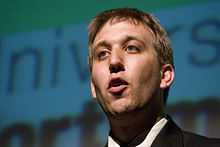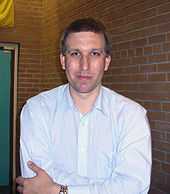Chris Lintott
| Chris Lintott | |
|---|---|
 Chris Lintott speaking at Southern Illinois University Edwardsville in 2008 | |
| Born |
Christopher John Lintott 1980 (age 34–35) Torbay |
| Citizenship | British |
| Institutions |
|
| Alma mater |
|
| Doctoral advisor |
|
| Known for | |
| Notable awards |
|
|
Website www2 | |
Christopher John "Chris" Lintott (born 1980) is Professor of Astrophysics and Citizen Science in the Department of Physics at Oxford University.[3][4] Lintott is involved in a number of popular science projects aimed at bringing astronomy to a wider audience. He is the primary presenter of the BBC series The Sky at Night, having previously been co-presenter with Sir Patrick Moore until Moore's death in 2012. Lintott co-authored Bang! – The Complete History of the Universe with Patrick Moore and Queen guitarist and astrophysicist Brian May.[5][6][7][8] [9][10]
Education
Lintott attended Torquay Boys' Grammar School in Devon. In 1999, while still at school, he won a $500 Earth and Space Sciences award and the Priscilla and Bart Bok Honorable Mention Award at the Intel International Science and Engineering Fair for an article on 'Cosmic dust Around Young stellar objects'. This came from a six-week project at the University of Hertfordshire funded by a Nuffield bursary. He read Natural Sciences at Magdalene College, Cambridge and received a PhD in astrophysics from University College London, for research on star formation.
Research and career
Lintott is currently co-director of the Programme on Computational Cosmology and Citizen Science Project Lead in the Department of Physics at the University of Oxford,[4][11] and a Research Fellow of New College, Oxford.[12] He was the Director of Citizen Science Initiatives at the Adler Planetarium from 2010 until 2012.[13]
His research focuses on galaxy evolution and the application of astrochemical models of star formation to galaxies beyond the Milky Way; particularly the use of sulphur compounds as a signature of stars that are in the process of formation.[14][15][16] After a recommendation from Ed Vaizey, former Culture Minister, Prime Minister David Cameron appointed Lintott as Astronomy Trustee of the National Maritime Museum (NMM). His appointment ran from the 24 June 2010 until 23 June 2014.[17]
Lintott's research has been published a wide variety of peer-reviewed scientific journals.[4][15][16][18][19] He was formerly a Fulford junior research fellow at Somerville College, Oxford between 2006 and 2010.[14][17]
Lintott's research has been funded by the Engineering and Physical Sciences Research Council (EPSRC), the Arts and Humanities Research Council (AHRC) and the Science and Technology Facilities Council (STFC).[20]
Popular science
The Sky at Night
Lintott first appeared on the BBC astronomy programme The Sky at Night, presented by Patrick Moore, as a guest in 2000. As Moore's mobility deteriorated, Lintott acquired an increasingly prominent role, often providing on-location reporting from events covered by the programme. In an interview in 2007, with Mark Lawson, Moore described him as "eminently suitable" as a presenter.[21] He jointly presented the programme with Moore until the latter's death in December 2012. Since the February 2013 episode, Chris Lintott has been a co-presenter with Lucie Green (until December 2013) and with Maggie Aderin-Pocock (since February 2014). In July 2004, Moore suffered a near-fatal bout of food poisoning and Lintott stood in as the sole presenter of that month's episode.[22] It was the only episode which Moore did not present since the show was first broadcast on 24 April 1957 until his death[23]
Galaxy Zoo & The Zooniverse
Lintott is the co-founder, along with Kevin Schawinski, of Galaxy Zoo,[2][24][25][26][27] an online crowdsourcing project where members of the public can volunteer their time to assist in classifying over a million galaxies.[2] The project was inspired by, among others, Stardust@home. Describing the Galaxy Zoo project, Lintott commented that: "One advantage is that you get to see parts of space that have never been seen before. These images were taken by a robotic telescope and processed automatically, so the odds are that when you log on, that first galaxy you see will be one that no human has seen before."[2]
Lintott is the P.I. for the citizen science web portal Zooniverse.[28] Quoting from the Zooniverse Team page: "Astronomer and founder of both Galaxy Zoo and the Zooniverse that grew from it, Chris is interested in how galaxies form and evolve, how citizen science can change the world".[28] Lintott is also the chair of the Citizen Science Alliance, the organisation that produces, maintains and develops The Zooniverse.[29]
Books

In October 2006, Chris Lintott, Patrick Moore and Brian May co-authored a book entitled Bang! – The Complete History of the Universe, which was produced by Canopus Books and published by Carlton Books on 23 October 2006.[5] It has been translated into 13 languages and has appeared in paperback. As suggested by the title, the illustrated book is a history of the Universe from the Big Bang to its eventual predicted end. It is aimed at a popular science audience and claims to make its subject matter easily comprehensible to readers without any knowledge of astronomy.[30]
In October 2012, Brian May, Patrick Moore and Chris Lintott co-authored a book entitled The Cosmic Tourist: The 100 Most Awe-inspiring Destinations in the Universe.[31] On the book's PR page, it is stated: "Take your seats for the greatest tour ever – one that encompasses no less than the whole of the Universe."[32]
Awards and honours
Lintott is a fellow of the Royal Astronomical Society.
In 2011, Lintott was awarded the Royal Society Kohn Award. He was awarded this (quoting from the Royal Society webpage): "For his excellent engagement with society in matters of science and its societal dimension." [33]
In 2013, Lintott was awarded the Oxford Internet Institute Internet and Society Award. He was given this (quoting from the OII website): "in recognition of Galaxy Zoo's outstanding contributions to research by using crowd-sourced citizen science to capitalise on the availability of online big data-sets."[14] In 2014, he received the Beatrice M. Tinsley Prize from the American Astronomical Society. He was awarded this (quoting from the AAS website): "For his insight and creativity that created a transformative approach to science by engaging nonscientists in cutting edge research."[34] Lintott was interviewed by Jim Al-Khalili for The Life Scientific in June 2014.[9]
See also
- Astronomy
- Reinventing Discovery
- Hanny's Voorwerp
- Pea galaxy
- List of citizen science projects
- List of crowdsourcing projects
References
- ↑ 1.0 1.1 "Chris Lintott". UCL. 12 December 2012. Retrieved 6 October 2014.
- ↑ 2.0 2.1 2.2 2.3 Lintott, C. J.; Schawinski, K.; Slosar, A. E.; Land, K.; Bamford, S.; Thomas, D.; Raddick, M. J.; Nichol, R. C.; Szalay, A.; Andreescu, D.; Murray, P.; Vandenberg, J. (2008). "Galaxy Zoo: Morphologies derived from visual inspection of galaxies from the Sloan Digital Sky Survey". Monthly Notices of the Royal Astronomical Society 389 (3): 1179. arXiv:0804.4483. Bibcode:2008MNRAS.389.1179L. doi:10.1111/j.1365-2966.2008.13689.x.
- ↑ Schmadel, Lutz D. (2012). Dictionary of Minor Planet Names (6th ed.). Springer. p. 402. ISBN 9783642297182.
- ↑ 4.0 4.1 4.2 "Chris Lintott profile". University of Oxford. Retrieved 6 October 2014.
- ↑ 5.0 5.1 Bang!: The Complete History of the Universe. Carlton Books Ltd. 2009. ISBN 1-84732-336-7.
- ↑ Brockes, Emma (19 October 2006). "Friend to the stars". London, UK: Guardian Unlimited Arts. Retrieved 27 November 2006.
- ↑ The Oxford Internet Institute interview, wards.oii.ox.ac.uk; accessed 15 March 2015.
An interview of Lintott by Victoria Nash of the OII - ↑ Chris Lintott Podcasts A collection of Lintotts' podcasts from the University of Oxford.
- ↑ 9.0 9.1 Chris Lintott interviewed by Jim Al-Khalili, The Life Scientific; accessed 18 March 2015.
- ↑ Chris Lintott on Twitter
- ↑ "Computational Cosmology". University of Oxford. Retrieved 6 October 2014.
- ↑ "Christopher Lintott". New College, Oxford. 2014. Retrieved 14 November 2014.
- ↑ "TVO Guests". TVO. 2014. Retrieved 6 October 2014.
- ↑ 14.0 14.1 14.2 "Chris Lintott Receives Internet and Society Award from the Oxford Internet Institute". University of Oxford. 2013. Retrieved 6 October 2014.
- ↑ 15.0 15.1 Chris Lintott's publications indexed by the Scopus bibliographic database, a service provided by Elsevier.
- ↑ 16.0 16.1 Chris Lintott publications in Google Scholar
- ↑ 17.0 17.1 "National Maritime Museum appointment". UK Government. Retrieved 6 October 2014.
- ↑ List of publications from Microsoft Academic Search
- ↑ "C.J. Lintott ADS citations". SAO/NASA. 6 October 2014. Retrieved 6 October 2014.
- ↑ UK Government research grants awarded to Chris Lintott, via Research Councils UK, gtr.rcuk.ac.uk; accessed 15 March 2015.
- ↑ http://www.bbc.co.uk/programmes/b01pz88g
- ↑ "A Brief Interview With Sir Patrick Moore". Universe Today. 15 November 2004. Retrieved 22 February 2007.
- ↑ "Sir Patrick hit by food poisoning". BBC News. 6 July 2004. Retrieved 22 February 2007.
- ↑ Bamford, S. P.; Nichol, R. C.; Baldry, I. K.; Land, K.; Lintott, C. J.; Schawinski, K.; Slosar, A. E.; Szalay, A. S.; Thomas, D.; Torki, M.; Andreescu, D.; Edmondson, E. M.; Miller, C. J.; Murray, P.; Raddick, M. J.; Vandenberg, J. (2009). "Galaxy Zoo: The dependence of morphology and colour on environment". Monthly Notices of the Royal Astronomical Society 393 (4): 1324. doi:10.1111/j.1365-2966.2008.14252.x.
- ↑ Schawinski, K.; Urry, C. M.; Virani, S.; Coppi, P.; Bamford, S. P.; Treister, E.; Lintott, C. J.; Sarzi, M.; Keel, W. C.; Kaviraj, S.; Cardamone, C. N.; Masters, K. L.; Ross, N. P.; Andreescu, D.; Murray, P.; Nichol, R. C.; Raddick, M. J.; Slosar, A. E.; Szalay, A. S.; Thomas, D.; Vandenberg, J. (2010). "Galaxy Zoo: The Fundamentally Different Co-Evolution of Supermassive Black Holes and Their Early- and Late-Type Host Galaxies". The Astrophysical Journal 711: 284. doi:10.1088/0004-637X/711/1/284.
- ↑ Lintott, C.; Schawinski, K.; Bamford, S.; Slosar, A. E.; Land, K.; Thomas, D.; Edmondson, E.; Masters, K.; Nichol, R. C.; Raddick, M. J.; Szalay, A.; Andreescu, D.; Murray, P.; Vandenberg, J. (2011). "Galaxy Zoo 1: Data release of morphological classifications for nearly 900 000 galaxies★". Monthly Notices of the Royal Astronomical Society 410: 166. doi:10.1111/j.1365-2966.2010.17432.x.
- ↑ Skibba, R. A.; Bamford, S. P.; Nichol, R. C.; Lintott, C. J.; Andreescu, D.; Edmondson, E. M.; Murray, P.; Raddick, M. J.; Schawinski, K.; Slosar, A. E.; Szalay, A. S.; Thomas, D.; Vandenberg, J. (2009). "Galaxy Zoo: Disentangling the environmental dependence of morphology and colour". Monthly Notices of the Royal Astronomical Society 399 (2): 966. doi:10.1111/j.1365-2966.2009.15334.x.
- ↑ 28.0 28.1 "The Zooniverse Team". The Zooniverse. 2013. Retrieved 6 October 2014.
- ↑ "Citizen Science Alliance website". Retrieved 28 September 2014.
- ↑ Kennedy, Maev (24 October 2006). "Guitarist joins astronomers to tell history of universe". Guardian Unlimited. Retrieved 7 January 2007.
- ↑ B. May, P. Moore, C. Lintott (11 October 2012). The Cosmic Tourist: The 100 Most Awe-inspiring Destinations in the Universe. Carlton Books. ISBN 978-1847326195.
- ↑ "The Cosmic Tourist". BangUniverse. 11 October 2012. Retrieved 7 October 2014.
- ↑ "Royal Society Kohn Award". The Royal Society. 2011. Retrieved 7 October 2014.
- ↑ "Beatrice M. Tinsley Prize". The American Astronomical Society. 2014. Retrieved 7 October 2014.
| Wikimedia Commons has media related to Chris Lintott. |
|